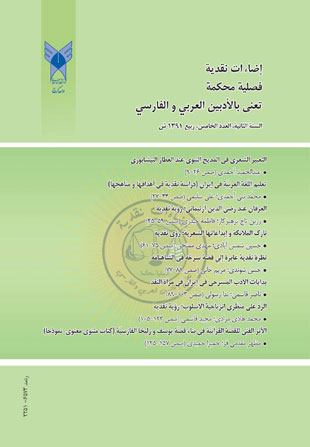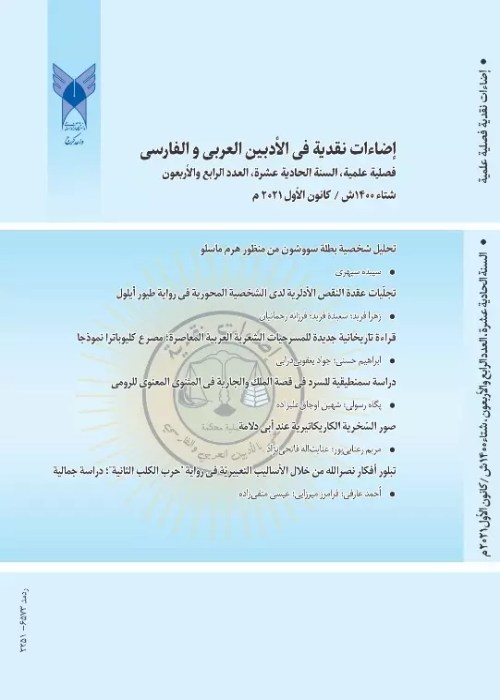فهرست مطالب

فصلنامه إضاءات نقدیه فی الادبین العربی و الفارسی
پیاپی 5 (ربیع 2012)
- تاریخ انتشار: 1391/02/15
- تعداد عناوین: 8
-
-
صفحات 45-59
-
صفحات 61-75
-
صفحات 77-88
-
صفحات 89-103
-
صفحات 105-123
-
Pages 9-26A poet's cast of mind manifests itself in his style as he perceives the world from a peculiar perspective. In fact, poets though they all follow some common features, investigate unique modes of writing. This leads into a sort of diversity especially by those poets who share common features. Amongst these features one may refer to glorification of prophets which invites various styles and modes. The researcher in this paper attempts to analyze the poetic representations in Attar's Madihe Nabavi.Key words: Imagery, simile, metaphor
-
Pages 27-44It is Necessary to know that the curriculum of teaching a language isnt a local science, so we must utilize these new Teaching methods in the world. The old methods need to be developed and changed constantly so that we may not be faced with the challenges of the new methods. For example, learning the second language according to the old methods like Grammar Translation Method is out of date in the world but we still use this method in spite of knowing the fact that it is useless. A glance at the English books and comparing them with the modern books indicates that there are attempts to modernize it. This essay tries to draw a picture of the desired situation to learn Arabic language in Iran. This aim cant be reached unless we know the situation of this language in Iran and its methodology in order to establish its practical bases. We must understand the defects of our educational systems and the reasons why our students cant speak Arabic fluently.Keywords: the scientific planning, Arabic language, new methods
-
Pages 45-59Mysticism is a knowledge based upon the mystic's moods in which man can communicate with God directly. Hence the word of mystic –prose or verse-is the expression of the mystic's experiences and his unique outlook in regard to universe. It is due to the same cause that his words transcend the physical world, understandable for those who are talented or gifted enough to perceive truth.Razi-ol-Din Artimani is one of these mystic poets of eleventh century (Hejri shamsi) whose poems were first published by Mohammad Ali Emami in 1346 (hejri shamsi). Among his poems which are nearly 1500 lines, Saghi Nameh is more well-known due to its pathetic feelings. This paper will examine his poetry as well as his character.Keywords: mysticism, absolute being, the word of mystic, practical experience, Saghi Nameh
-
Pages 61-75
This article probes the career of the Iraqi poetess Nazik al-Mal’ika who earned a vital role in modern Arabic poetry from 1940’s through 1960’s. This lady entered a literary battle traditionally undertaken by men and actually did prove her creativity and originality and secured for herself an unimpeachable status in the canon of Arabic literature. Nazik is the Iraqi representative of the romantic school of poetry that is based on creativity and not imitation. Nazik was responsible for an evolution in this school which had virtually reached Iraq late. Nazik was one of the pioneers of poetic transformation. Such transformation had already spread across many countries around the world. This fine poetess championed the propagation of originality, novelty, and criticism in Arabic poetry. Nazik experienced cultural and sexual discrimination in a conservative family and society dominated by male chauvinism which deprived women from self-expression. Nazik could not attend literary clubs and gatherings and in compliance to public opinion was inhibited like other women from integrating with men in social contexts.
Keywords: Arabic literature, the modern period, Iraq, Nazik al Malika, Romanticism, poetic inventiveness -
Pages 77-88Among the stories of shahname, sometimes you can see stories which can be studied separate from the main one. One of these, is the story about Sorkhe the famous e son of Afrasiab in the war between Iran and Tooran which occurred to claim the blood of Siavash. Sorkhe has the same destiny as Siavosh. Now the question which probably occurs to mind is why Rustam did not forgive him. The answer is in the epic war and stories, that during the war the good enemy and the evil friend are infused. As Afrasiab, sacrifices Siavash by the name of enemy and doesn’t let the blood to raised and the other matter is that when someone's death approaches, nothing can be done. These stories which culminate to the death of a hero first have to be seen by the view of epics, as Shahname is specialized to epic stories, though ending of this epic story is tragic. In this study the researcher tries to see the roots of Rustam's motivation for killing this innocent boy, and in doing so to arouse the reader's and sometimes the poet's rage.Keywords: Sorkhe, epic, tragic, Rustam, Afrasiab
-
Pages 89-103In addition to the different arts, in ancient Iran, there were ruins of the festivals and religious rituals indicating an early past existence of theatre and drama. After Islam Iran witnessed other kinds of theatre, deriving their subjects from folk literature and legends like: AL taezia, Mirnorozy (AL Nyrouz Prince), Imitation and AL hood show and several others. Throughout the Samanian period (858 – 968) Iran witnessed a great flourishing of literature, particularly theatre and drama. But after the Mogul attack on Iran, literature and culture went into decline. This lasted until the beginning of Safawian period early sixteenth century when literature was revived and theatre came to the fore although primitively.Iran knew modern western literature in all its artistic forms since mid nineteenth century, particularly after constructing Dar al Fonun (the school where modern arts and sciences are being taught) in Tehran and the start of translation from European languages. Mirza Agha Tabrizi was the first writer and dramatist to write three short plays in 1866. He published some of them in al-Ittihād Newspaper (in Tabriz) in 1908, getting some help in expressing his political and philosophic opinions through the dramatically artistic writing.Keywords: Drama, Iran, literature, Genesis, Art
-
Pages 105-123The term “stylistics” has started with the emergence of linguistic research at the first decades of twentieth century. Charles Bally (1865-1947), is the founder of modern stylistics in the French School, and is a substitute for Saussure at the Linguistics Department of University of Geneva. Stylistics is a sort of criticism process that reveals the aesthetic bases of literary works. One of the most prominent kinds of stylistics is deviation; it is some kinds of variety and alteration which enhances text’s value. Deviation is a technique of communicating between creator and recipient, because this technique reveals the capability of creator in using the hidden part of language to convey the message to the recipient with its all stylistic value. So style deviates from the norm to reveal the objectives that normal language is not able to convey. But some theorists believe that the style is nothing more than deviation. This article tries to criticize this opinion by using examples from poetry and holy Quran.Keywords: deviation, stylistics, criticism on style deviation
-
Pages 125-157Definitely, Koran's tales are considered as one of the important tools for improving man and correcting his thoughts. The three elements of character, place (Scene) and time play some important roles in the establishment of literary devices of Koran since God has considered all mental and social aspects of man in every time and place. In this research we study the effects of Koranic tales on the Persian tales. With no doubt, the effect could be seen in the literary skills, particularly in prose and poem of Molavi in his 7th century book. He has established an important communication method with ordinary people’s lives under the flag of Islam because poetry has had a significant role in the Iranian religion. In this research, a brief remark is given on Maulavi’s life and his valuable book, “Masnavi” and in addition to above-mentioned methods, the following will be traced as well: the structure of arts feature of space and scenery (time and place), the subsequence of happenings, the story’s events, flash backs or flash forwards, the relationship and cohesion of length, the text and theme in terms of abstraction and/or full description of the tale.Keywords: Koran's tales, Joseph, Zuleikha, artistic representations, setting, characterization


